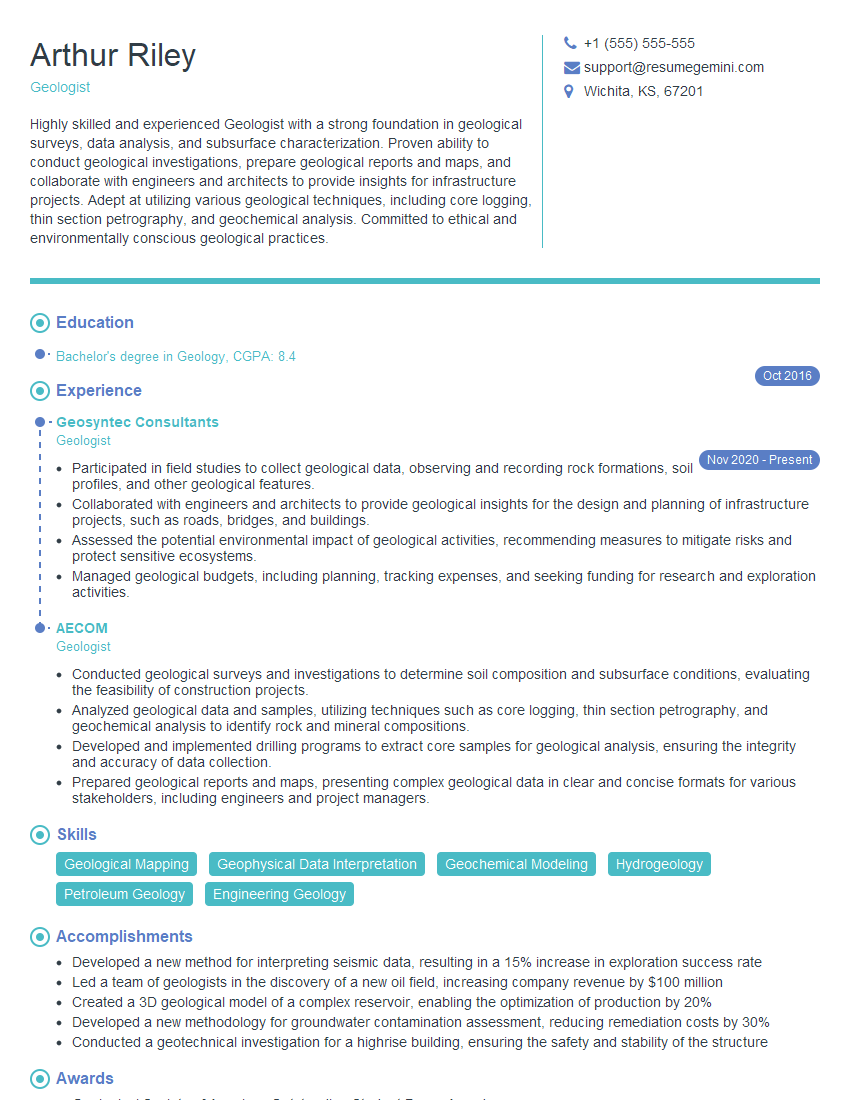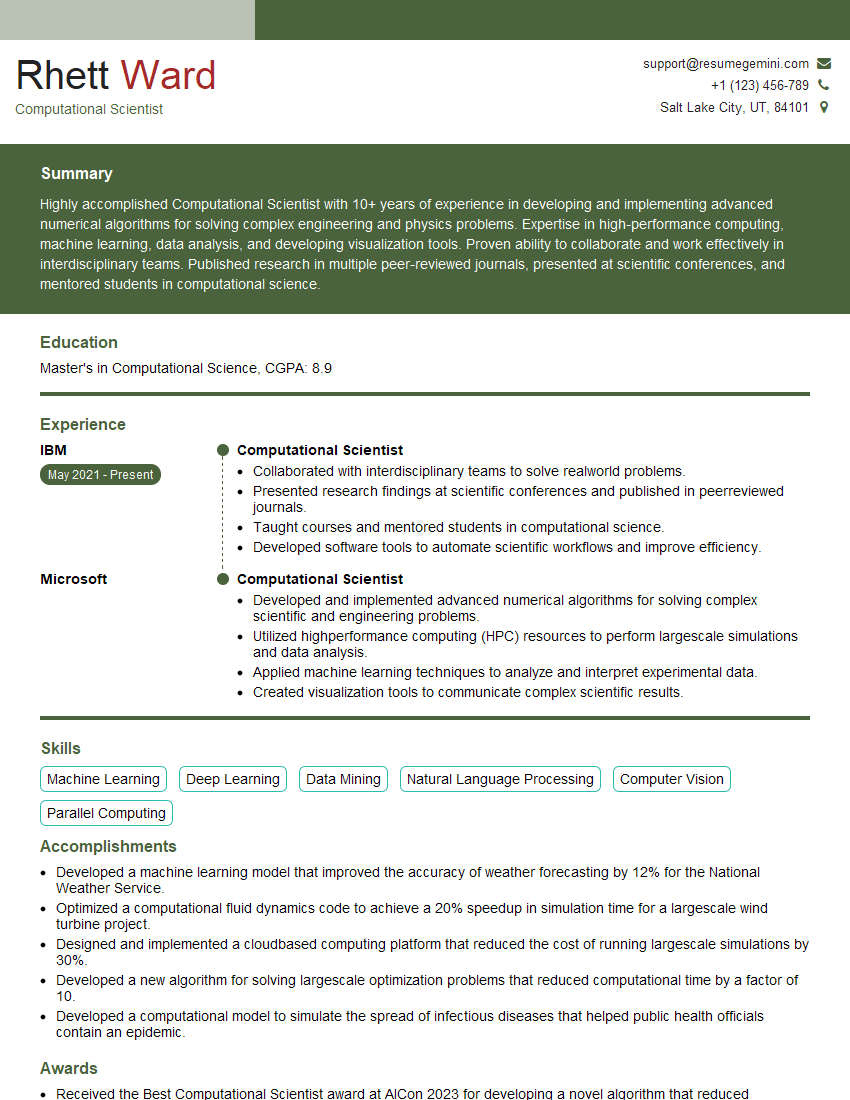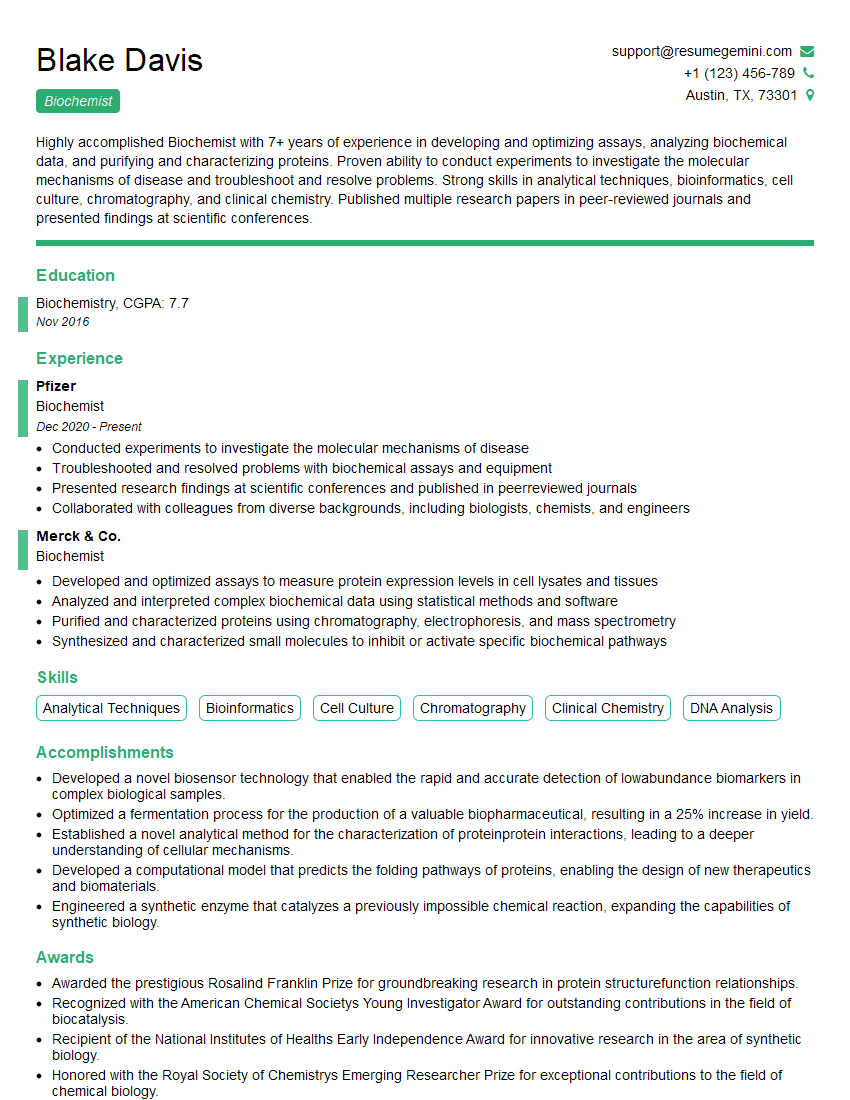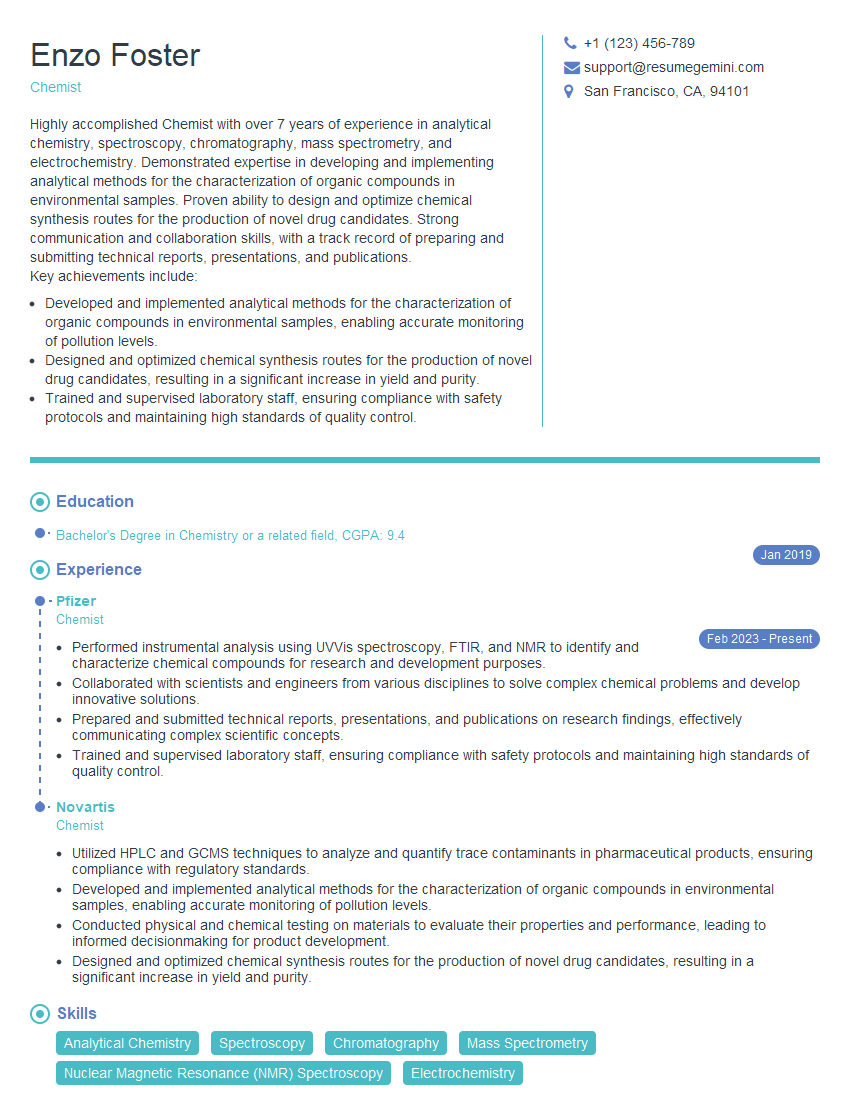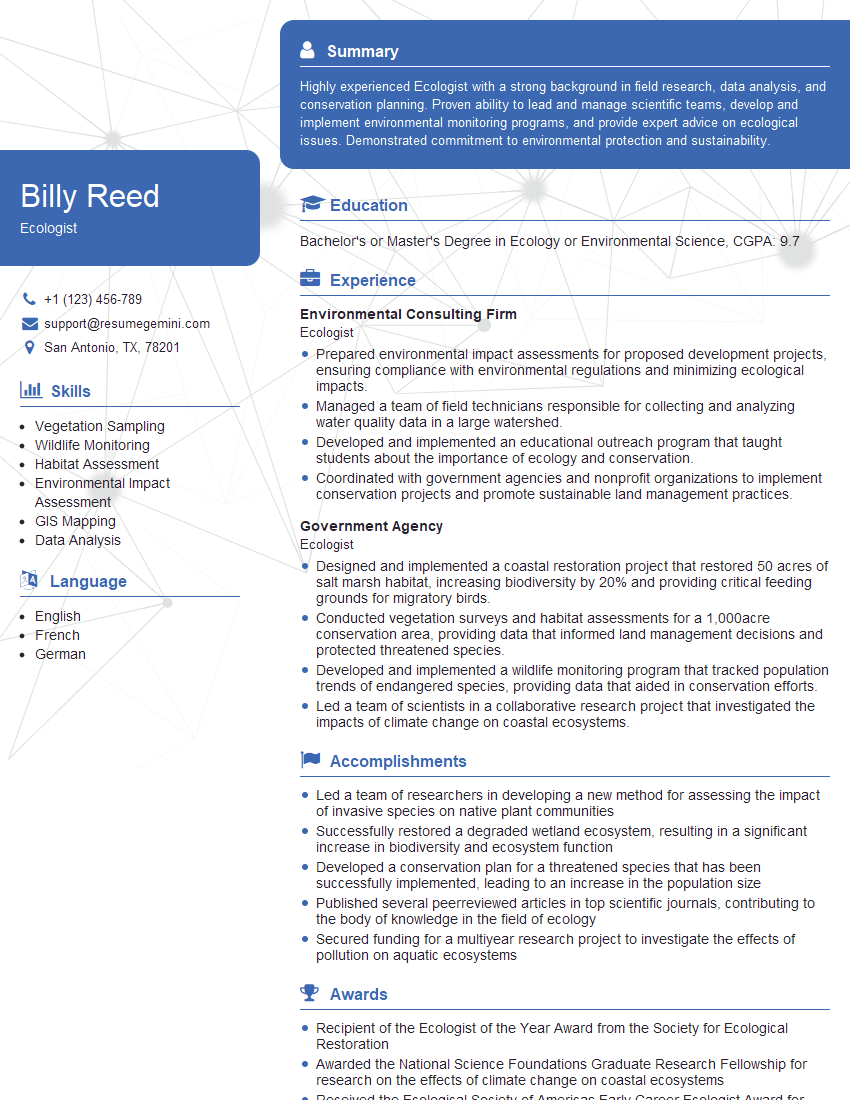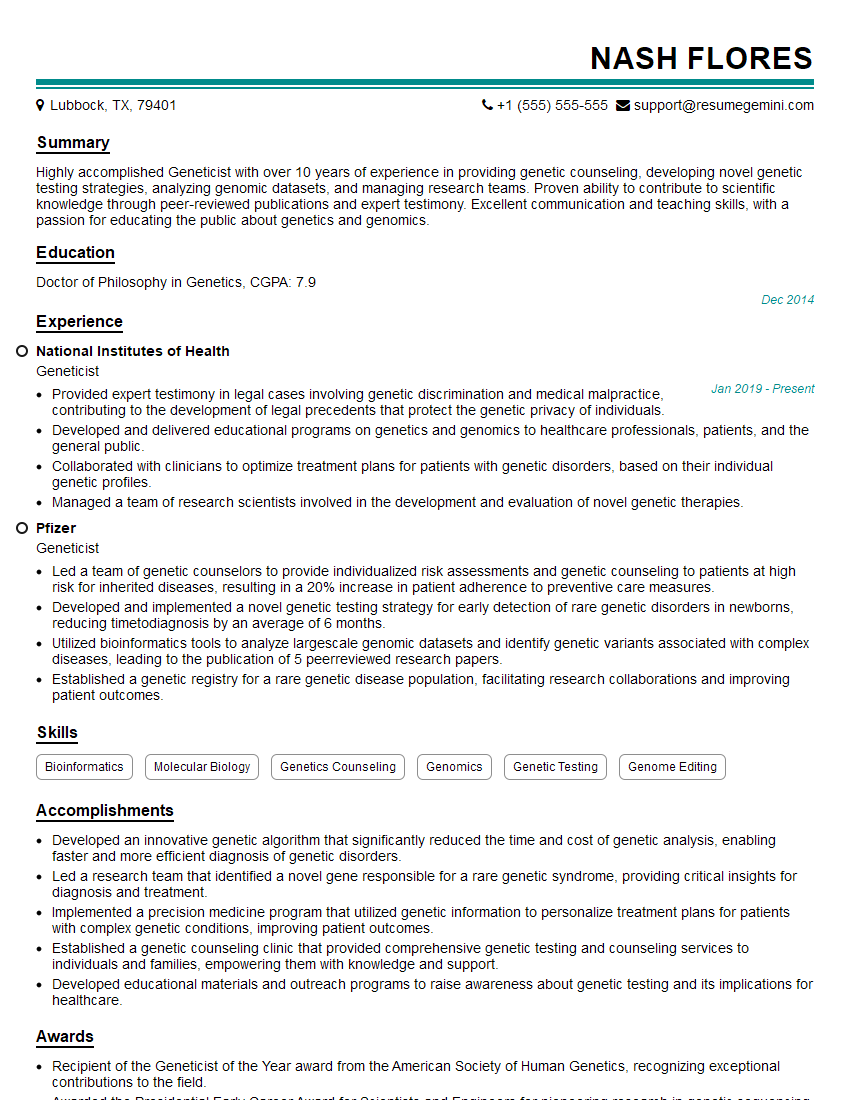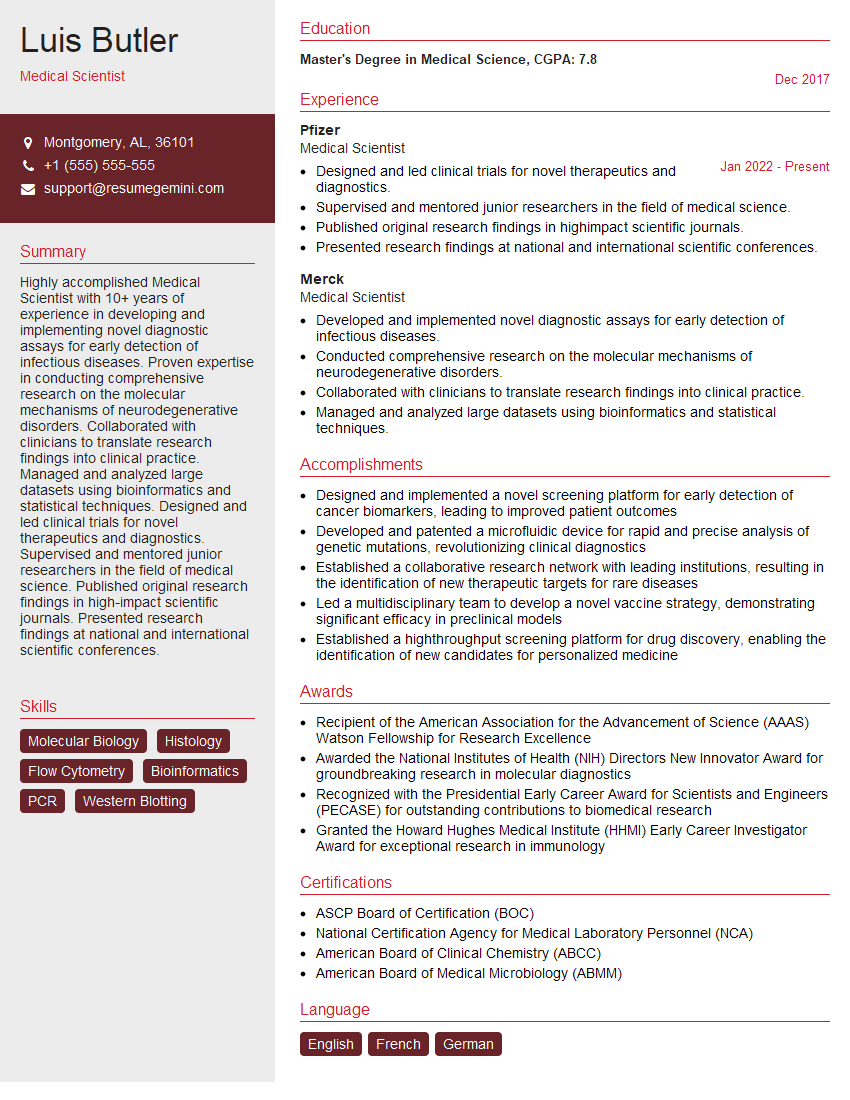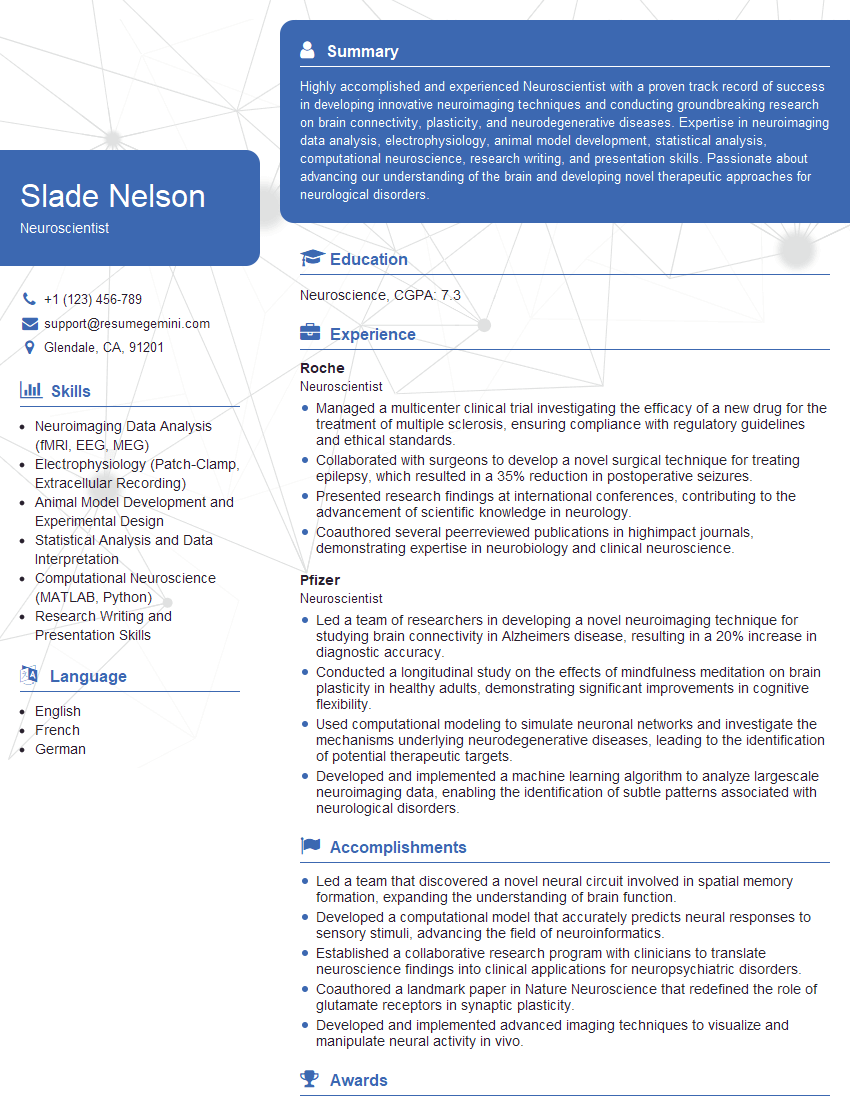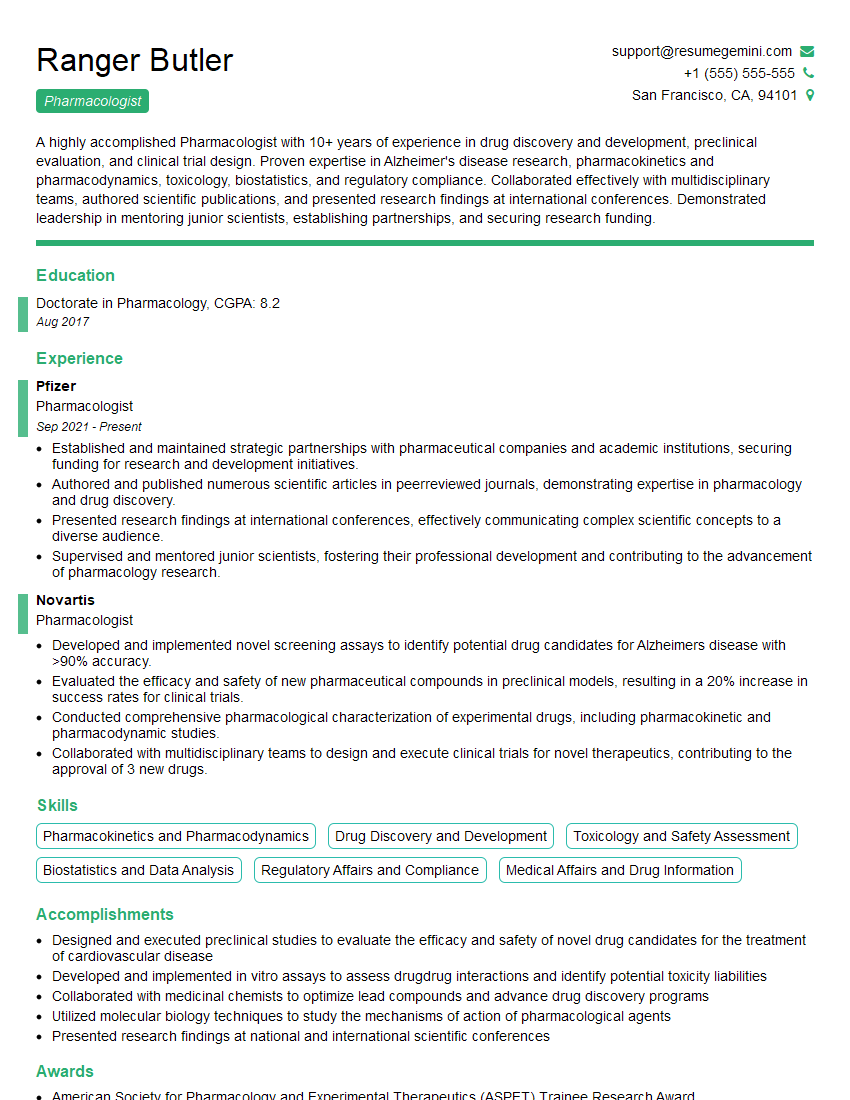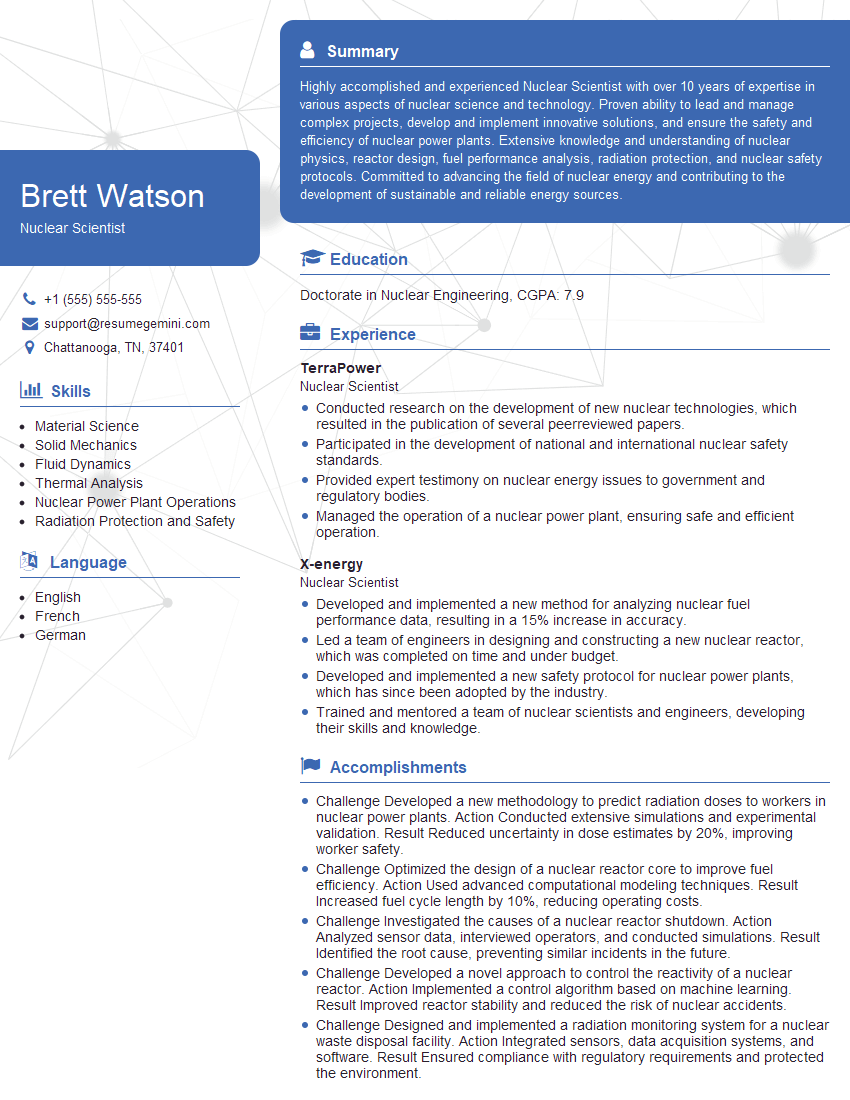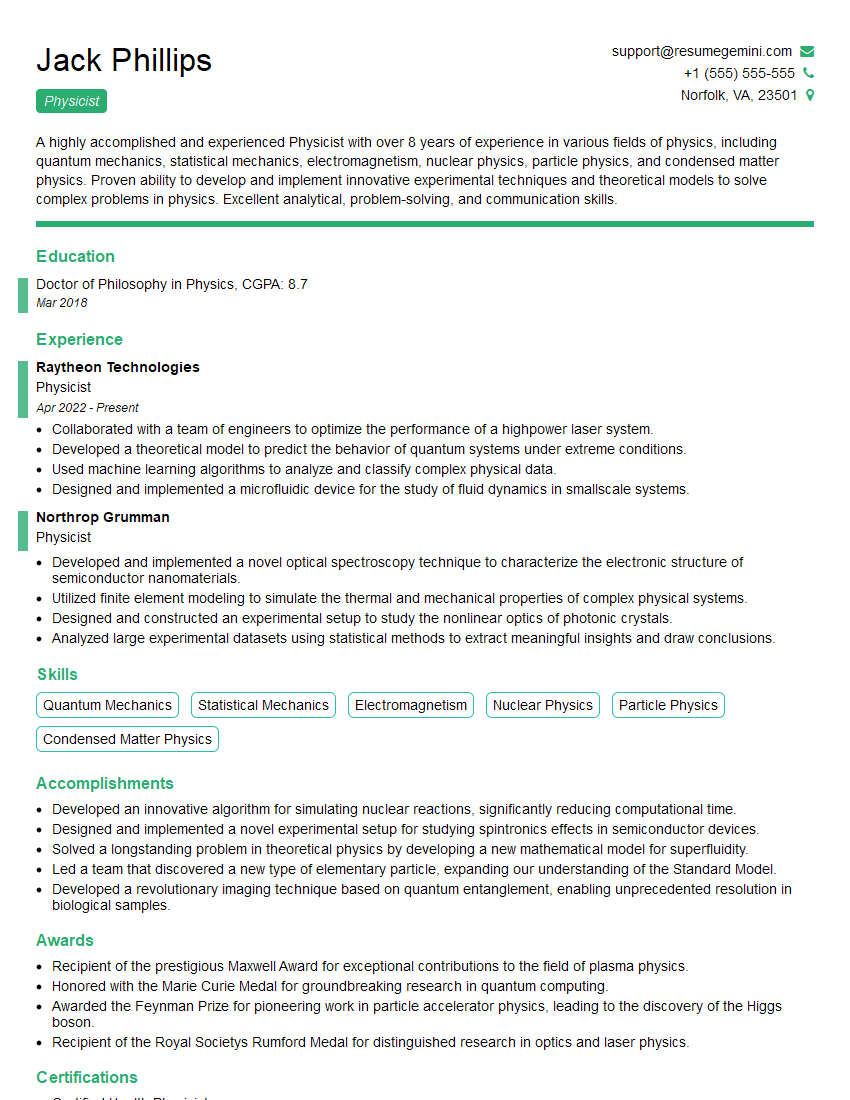Interviews are opportunities to demonstrate your expertise, and this guide is here to help you shine. Explore the essential Understanding of scientific principles and concepts interview questions that employers frequently ask, paired with strategies for crafting responses that set you apart from the competition.
Questions Asked in Understanding of scientific principles and concepts Interview
Q 1. Explain the scientific method.
The scientific method is a systematic approach to investigating and understanding the natural world. It’s not a rigid set of steps, but rather a flexible framework guiding inquiry. It generally involves these key stages:
- Observation: Carefully noticing and documenting a phenomenon or problem. This could involve gathering data through experiments or simply observing natural events.
- Question: Formulating a specific, testable question about the observation. This question should aim to explain the phenomenon or solve the problem.
- Hypothesis: Proposing a tentative explanation (a hypothesis) to answer the question. This is an educated guess, a prediction based on prior knowledge and observations. It must be falsifiable – meaning it can be proven wrong through experimentation.
- Prediction: Making a specific prediction based on the hypothesis. This prediction should outline what results would be expected if the hypothesis is true.
- Experimentation: Designing and conducting an experiment to test the prediction. This involves controlling variables, collecting data, and carefully documenting the process.
- Analysis: Analyzing the data collected during the experiment. This usually involves statistical analysis to determine if the results support or refute the hypothesis.
- Conclusion: Drawing conclusions based on the analysis. This involves determining whether the hypothesis was supported or rejected. Even if the hypothesis is rejected, valuable information is gained, leading to refinements or new hypotheses.
- Communication: Sharing the findings with the scientific community through publications, presentations, or other means. This allows for peer review and further investigation.
Think of it like detective work: you observe a crime (phenomenon), develop theories (hypotheses), collect evidence (data), and analyze it to solve the case (draw conclusions).
Q 2. Describe a time you applied the scientific method to solve a problem.
During my graduate studies, I investigated the effects of different soil compositions on plant growth. My observation was that plants in one area of the field consistently grew larger than those in another, despite seemingly similar conditions. My question was: What specific soil components account for this difference in plant growth? My hypothesis was that the higher growth was due to a higher concentration of nitrogen in the soil. I designed an experiment where I collected soil samples from both areas, analyzed their nitrogen content, and then grew the same type of plant in controlled pots using soil samples from each area. After several weeks, I measured plant height and biomass. Data analysis showed a statistically significant correlation between higher nitrogen levels and increased plant growth, supporting my hypothesis.
Q 3. What is the difference between a hypothesis and a theory?
A hypothesis is a specific, testable prediction about a phenomenon. It’s a tentative explanation that can be proven wrong through experimentation. A theory, on the other hand, is a well-substantiated explanation of some aspect of the natural world, based on a large body of evidence from many different studies. It’s not just a guess; it’s a robust explanation supported by considerable data and rigorous testing.
Think of it like this: a hypothesis is a single building block, while a theory is a whole skyscraper built from many carefully tested and interconnected blocks. A hypothesis might be, ‘Adding fertilizer will increase plant growth.’ A theory is something like the theory of evolution, supported by decades of research across many disciplines.
Q 4. Explain the concept of peer review in scientific research.
Peer review is a crucial process in scientific research where experts in a field critically evaluate a research study before publication. Before a scientific paper is published in a reputable journal, it is sent to several other scientists specializing in the same area. These reviewers assess the study’s methodology, data analysis, interpretation of results, and overall contribution to the field. They look for flaws, biases, or inconsistencies, and they provide constructive feedback to the authors. This process ensures quality control, improves the rigor of scientific research, and helps to maintain the integrity of the scientific literature. It’s a safeguard against flawed or biased research reaching a wider audience.
Q 5. What are some common experimental errors and how can they be avoided?
Common experimental errors include:
- Measurement errors: Inaccurate or imprecise measurements due to faulty equipment, inadequate calibration, or human error. Solution: Use calibrated instruments, repeat measurements, and employ multiple observers.
- Sampling bias: A non-representative sample, leading to skewed results. Solution: Use random sampling techniques and ensure a large enough sample size.
- Confounding variables: Uncontrolled variables that influence the outcome of the experiment. Solution: Carefully control experimental conditions and use control groups.
- Observer bias: The researcher’s expectations influencing the observation or interpretation of data. Solution: Employ blinding techniques (double-blind studies) where the researcher and participant are unaware of treatment conditions.
- Data analysis errors: Incorrect statistical methods or misinterpretation of results. Solution: Employ appropriate statistical tests and ensure a thorough understanding of the analysis techniques.
Q 6. How do you interpret statistical data in scientific research?
Interpreting statistical data involves determining whether observed patterns are due to genuine effects or random chance. This often involves hypothesis testing, calculating p-values, and understanding confidence intervals. A p-value indicates the probability of obtaining the observed results (or more extreme results) if there was no real effect. A low p-value (typically below 0.05) suggests that the results are unlikely due to chance alone, providing support for the hypothesis. Confidence intervals provide a range of plausible values for the true effect, reflecting the uncertainty associated with the estimate. For example, a 95% confidence interval means that if the study were repeated many times, 95% of the resulting confidence intervals would contain the true value.
It’s crucial to consider effect size alongside p-values. A statistically significant result (low p-value) might have a small effect size, meaning the effect is real but practically insignificant. Context is also important – the interpretation must be within the context of the research question, experimental design, and limitations.
Q 7. Describe your understanding of data analysis techniques used in your field.
In my field (replace with your field, e.g., ‘ecology’), common data analysis techniques include:
- Regression analysis: To examine relationships between variables. For example, I might use linear regression to model the relationship between plant growth and nitrogen levels.
- ANOVA (Analysis of Variance): To compare means across different groups. This might be used to compare plant growth across different soil types.
- t-tests: To compare the means of two groups. This could be used to compare the growth of plants in two different treatments.
- Non-parametric tests: When data doesn’t meet the assumptions of parametric tests (e.g., normality). These tests can handle non-normally distributed data.
- Multivariate analysis: Techniques like PCA (Principal Component Analysis) or RDA (Redundancy Analysis) are used to analyze data with multiple variables simultaneously.
Proficiency in statistical software (like R or SPSS) is essential for performing these analyses and interpreting the results correctly. It’s critical to choose the appropriate statistical test based on the research question, data type, and assumptions of the tests.
Q 8. Explain the concept of causality and correlation.
Causality and correlation are two fundamental concepts in statistics and research. Correlation refers to a statistical relationship between two or more variables. It simply means that changes in one variable are associated with changes in another. However, correlation does not imply causation. Causality, on the other hand, implies a direct cause-and-effect relationship between variables; one variable directly influences the other.
Example: Ice cream sales and crime rates are often positively correlated – both tend to increase during summer. This doesn’t mean that buying ice cream causes crime, or vice versa. The underlying causal factor is the warmer weather, influencing both ice cream consumption and crime rates independently.
In scientific research, establishing causality requires careful experimental design, often using controlled experiments to isolate the effect of one variable on another, ruling out other possible explanations. Simply observing a correlation is insufficient to prove causality.
Q 9. What is the difference between accuracy and precision in measurements?
Accuracy and precision are crucial aspects of measurement, often confused but distinct. Accuracy refers to how close a measurement is to the true or accepted value. Precision refers to how close repeated measurements are to each other.
Think of a dartboard: High accuracy means your darts are clustered around the bullseye, regardless of how spread out they are. High precision means your darts are clustered closely together, regardless of whether they’re near the bullseye. Ideally, you want both high accuracy and high precision.
- High Accuracy, Low Precision: Your average is close to the true value, but individual measurements vary widely.
- Low Accuracy, High Precision: Your measurements are consistent, but consistently far from the true value.
- High Accuracy, High Precision: Your measurements are consistent and close to the true value (the ideal scenario).
- Low Accuracy, Low Precision: Your measurements are inconsistent and far from the true value.
In a laboratory setting, ensuring both accuracy and precision involves using calibrated instruments, employing proper measurement techniques, and repeating measurements to assess reliability.
Q 10. Explain the significance of control groups in scientific experiments.
Control groups are essential in scientific experiments to isolate the effect of the independent variable (the variable being manipulated) on the dependent variable (the variable being measured). A control group doesn’t receive the treatment or manipulation applied to the experimental group. By comparing the experimental group to the control group, researchers can determine whether the observed changes in the dependent variable are due to the treatment or other factors.
Example: In a drug trial, the experimental group receives the new drug, while the control group receives a placebo (an inactive substance). Any differences in outcome between the groups can be attributed to the drug’s effect, assuming other factors are controlled.
Without a control group, it’s impossible to confidently attribute observed changes to the independent variable. The control group provides a baseline for comparison, allowing researchers to isolate the effect of the treatment and draw valid conclusions.
Q 11. Describe different types of scientific research designs (e.g., observational, experimental).
Scientific research designs broadly fall into two categories: observational and experimental.
- Observational studies involve observing and measuring variables without manipulating them. Researchers collect data and look for correlations but cannot establish causality definitively. Types include:
- Cohort studies: Following a group over time to observe outcomes.
- Case-control studies: Comparing individuals with a condition to those without.
- Cross-sectional studies: Observing a population at a single point in time.
- Experimental studies involve manipulating an independent variable to observe its effect on a dependent variable. Researchers control extraneous variables to establish causality. This often involves:
- Randomized controlled trials (RCTs): Participants are randomly assigned to different groups (treatment and control) to minimize bias.
- A/B testing: Comparing two versions of something (e.g., a website design) to see which performs better.
The choice of design depends on the research question and ethical considerations. Observational studies are useful for exploring correlations and generating hypotheses, while experimental studies are better suited for testing cause-and-effect relationships.
Q 12. How do you evaluate the credibility of scientific information?
Evaluating the credibility of scientific information requires a critical approach. Consider these factors:
- Source: Is the information from a reputable source like a peer-reviewed journal, a respected scientific institution, or a government agency? Be wary of information from biased sources or websites with questionable credentials.
- Peer Review: Has the information undergone peer review, meaning it has been evaluated by other experts in the field? Peer review helps ensure the quality and validity of research findings.
- Methodology: Is the methodology clearly described and appropriate for the research question? Are the sample size and statistical analyses adequate? Consider the limitations of the study.
- Replication: Has the research been replicated by other independent researchers? Replication increases confidence in the findings.
- Evidence-based reasoning: Is the information supported by strong evidence? Does the information align with established scientific knowledge? Look for logical reasoning and a lack of contradictions.
- Author Expertise: What are the qualifications and expertise of the authors? Are they recognized experts in their fields?
- Bias and Conflicts of Interest: Are there potential biases or conflicts of interest that could influence the information? Be critical of research funded by organizations with vested interests.
By critically assessing these factors, you can better determine the trustworthiness and reliability of scientific information.
Q 13. Explain a specific scientific principle relevant to your field.
A crucial scientific principle in many fields, including environmental science and chemistry, is the law of conservation of mass. This law states that in a closed system, mass is neither created nor destroyed during a chemical reaction or physical transformation. The total mass of the reactants equals the total mass of the products.
Example: When you burn wood, it seems like mass is lost as ash is much lighter than the original wood. However, the mass of the gases (carbon dioxide, water vapor) released during combustion must be accounted for. If we carefully measure the mass of all reactants (wood and oxygen) and products (ash, carbon dioxide, water), the total mass will remain constant, illustrating the law.
This principle is fundamental in understanding chemical reactions, balancing equations, and environmental processes like carbon cycling. It has wide-ranging implications in various scientific disciplines.
Q 14. Describe a complex scientific concept you’ve mastered.
I’ve mastered the concept of quantum entanglement, a phenomenon in quantum mechanics where two or more particles become linked together in such a way that they share the same fate, regardless of the distance separating them. Measuring the property of one entangled particle instantly determines the corresponding property of the other, even if they are light-years apart.
This defies classical intuition because it suggests faster-than-light communication, although it’s important to note that entanglement doesn’t allow for the transmission of information faster than light. The correlation between the particles is predetermined at the moment of entanglement, not communicated instantaneously.
Understanding quantum entanglement involves grasping concepts like superposition (a particle can exist in multiple states simultaneously) and wave-particle duality (particles exhibit both wave-like and particle-like properties). It has profound implications for quantum computing, cryptography, and our understanding of the fundamental nature of reality.
While counterintuitive, the mathematical formalism of quantum mechanics accurately predicts and explains entangled behavior, as confirmed through numerous experiments.
Q 15. How do you approach problem-solving using scientific principles?
My approach to problem-solving using scientific principles is systematic and iterative. It begins with clearly defining the problem, formulating a testable hypothesis, and designing an experiment or investigation to test that hypothesis. This involves identifying relevant variables, controlling for confounding factors, and selecting appropriate methodologies. Then, I collect and analyze data rigorously, employing statistical methods to assess significance and draw evidence-based conclusions. Crucially, I’m open to revising my hypothesis or approach based on the results. This cyclical process, characteristic of the scientific method, ensures a robust and reliable solution. For instance, if faced with a malfunctioning piece of lab equipment, I wouldn’t just replace it; I’d systematically check power supply, connections, and calibration, potentially even consulting manuals or online resources, before concluding a replacement is necessary.
- Define the problem: Clearly state the issue to be addressed.
- Formulate a hypothesis: Propose a testable explanation.
- Design the experiment/investigation: Plan a systematic approach.
- Collect and analyze data: Gather and interpret results using appropriate methods.
- Draw conclusions: Based on evidence, support or refute hypothesis.
- Iterate: Revise hypothesis and methodology as needed.
Career Expert Tips:
- Ace those interviews! Prepare effectively by reviewing the Top 50 Most Common Interview Questions on ResumeGemini.
- Navigate your job search with confidence! Explore a wide range of Career Tips on ResumeGemini. Learn about common challenges and recommendations to overcome them.
- Craft the perfect resume! Master the Art of Resume Writing with ResumeGemini’s guide. Showcase your unique qualifications and achievements effectively.
- Don’t miss out on holiday savings! Build your dream resume with ResumeGemini’s ATS optimized templates.
Q 16. How do ethical considerations influence scientific research?
Ethical considerations are paramount in scientific research, guiding every stage from experimental design to data reporting. They ensure the research is conducted responsibly, minimizing harm to participants (human or animal) and respecting their rights and autonomy. Informed consent, data privacy, and the responsible use of resources are critical ethical aspects. For instance, fabricating data or selectively reporting results undermines the integrity of science and erodes public trust. Similarly, animal research must adhere to strict guidelines, minimizing animal suffering and maximizing the scientific value of the research. Ethical review boards play a crucial role in ensuring research adheres to these principles. Failure to consider ethical implications can lead to serious consequences, including legal repercussions and reputational damage.
Q 17. Describe a time you had to troubleshoot a scientific experiment.
During my PhD research on protein crystallization, I encountered significant challenges. After weeks of optimization, my protein samples consistently failed to crystallize, a crucial step in structural analysis. My initial hypothesis focused on pH and temperature. However, repeated experiments yielded no crystals. I systematically troubleshooted: I re-examined the purity of my protein using different chromatography methods. I meticulously checked the buffer composition, ensuring there were no contaminations. I even collaborated with another lab to rule out problems with my equipment. Eventually, I discovered that a seemingly minor change in the protein concentration dramatically improved crystallization. This experience highlighted the importance of methodical troubleshooting, careful data analysis, and collaboration in overcoming scientific challenges.
Q 18. Explain your understanding of uncertainty and error in scientific measurements.
Uncertainty and error are inherent in all scientific measurements. Uncertainty reflects the limits of precision in our instruments and the variability in our experimental techniques. It acknowledges that there’s a range of possible values, not a single precise value. Error, on the other hand, refers to the difference between a measured value and the true value. Errors can be systematic (consistent bias) or random (unpredictable variations). For instance, a ruler might have a systematic error if it’s not perfectly calibrated, consistently giving slightly smaller or larger measurements. Random error, conversely, arises from human variability or minor fluctuations in experimental conditions. Understanding and quantifying uncertainty and error is crucial for evaluating the reliability and validity of experimental findings. This involves using appropriate statistical methods to estimate uncertainty, and employing techniques to minimize systematic and random error.
For example, when measuring the length of an object multiple times using a ruler, we wouldn’t expect to get exactly the same reading each time. The variation represents random error. If we found that our measurements are consistently smaller than the actual length, we would have a systematic error.
Q 19. How do you communicate complex scientific information to a non-technical audience?
Communicating complex scientific information to a non-technical audience requires a thoughtful approach that prioritizes clarity and accessibility. I avoid jargon and technical terms unless absolutely necessary, and when used, I provide clear definitions. Analogies and metaphors are powerful tools; they make complex concepts relatable to everyday experiences. Visual aids like charts, graphs, and illustrations can significantly enhance understanding. Storytelling can also engage the audience and make the information more memorable. For instance, explaining the concept of DNA replication using a zipper analogy can be more effective than using technical terms.
I also tailor my communication style to the specific audience, considering their prior knowledge and interests. Simplicity and conciseness are paramount. Instead of delving into intricate details, I focus on the essential message and its implications. Feedback is also important to gauge comprehension and adjust the communication accordingly.
Q 20. Describe your experience with data visualization in science.
Data visualization is integral to my scientific workflow. I’ve extensive experience using various software packages (e.g., R, Python with Matplotlib and Seaborn) to create informative and visually appealing representations of my data. I utilize different chart types depending on the nature of the data and the message I want to convey: scatter plots for correlations, bar charts for comparisons, and line graphs for trends over time. I pay close attention to aspects like axis labels, legends, and overall aesthetics to ensure clarity and avoid misleading interpretations. For instance, in my research, I used heatmaps to visualize protein-protein interaction networks, highlighting key interactions and revealing patterns that would have been difficult to identify through raw data analysis alone. Effective data visualization is crucial for both presenting results and identifying insights within the data.
Q 21. What are some limitations of scientific models?
Scientific models, while invaluable tools, have inherent limitations. They are simplifications of complex systems, inevitably omitting certain details for the sake of tractability. These omissions can lead to inaccuracies or incomplete predictions. Models are also based on assumptions, and if those assumptions are incorrect or incomplete, the model’s predictions will be unreliable. Furthermore, models are only as good as the data they are based on. Biased or incomplete data will lead to biased or incomplete models. For example, climate models are incredibly complex but still rely on simplifications of atmospheric processes, land use changes, and feedback mechanisms. These simplifications mean the predictions will have associated uncertainties. It’s crucial to understand the limitations of any model and interpret its predictions critically, acknowledging the uncertainties inherent in its simplified representation of reality.
Q 22. Explain the concept of scientific reproducibility.
Scientific reproducibility refers to the ability of independent researchers to obtain the same results using the same methods and data. It’s the cornerstone of reliable science, ensuring that findings aren’t flukes or artifacts of a specific experiment. Think of it like a recipe: if you follow a recipe precisely, you expect the same outcome each time. Similarly, a reproducible scientific study should yield consistent results when repeated by others.
Reproducibility involves meticulous documentation of every step of the research process, including materials, methods, data analysis techniques, and any relevant code. This detailed documentation allows others to verify the results and build upon the findings. A lack of reproducibility raises serious questions about the validity and reliability of the original study’s conclusions, potentially leading to retractions or further investigation.
For example, consider a study investigating the effectiveness of a new drug. Reproducibility would mean that other researchers, using the same drug dosage, patient population, and experimental protocols, would obtain similar results regarding the drug’s efficacy and safety. If another team conducts the same study and gets drastically different outcomes, it indicates a problem with the original study’s design, execution, or reporting.
Q 23. How do you stay current with advances in your field of science?
Staying current in a rapidly evolving field like science requires a multi-pronged approach. I regularly read peer-reviewed scientific journals, focusing on publications in top-tier journals relevant to my specialization. I also attend conferences and workshops, which provide opportunities to network with other researchers and learn about the latest discoveries firsthand. These events often involve presentations of cutting-edge research and offer a chance for insightful discussions.
Beyond journals and conferences, I actively engage with online resources such as preprint servers (like arXiv), which allow researchers to share their work before formal publication. This gives me early access to emerging research and allows me to follow the progress of particular studies. I also utilize online databases like PubMed and Google Scholar to track keywords related to my area of expertise, ensuring I remain updated on new publications and related advancements. Further, I follow prominent researchers and institutions on social media platforms (carefully and critically) to stay informed about significant breakthroughs.
Q 24. Describe your experience using specific scientific equipment or software.
My experience encompasses a wide range of scientific equipment and software. I’m proficient in using advanced imaging techniques like confocal microscopy, which allows for high-resolution three-dimensional imaging of biological samples. I’ve extensively utilized flow cytometry for analyzing cellular populations based on various parameters like size, granularity, and antigen expression. This involves preparing samples, running the instrument, and then analyzing the resulting data using dedicated software.
In terms of software, I am highly skilled in statistical programming languages such as R and Python, which are crucial for data analysis and visualization. I regularly use packages like ggplot2 (in R) and matplotlib (in Python) for creating publication-quality figures and conducting statistical tests. Furthermore, I have experience with bioinformatics software for analyzing genomic and proteomic data, often utilizing command-line tools and scripting to manage and process large datasets. For example, I’ve used BLAST for sequence alignment and Gene Ontology tools for functional annotation.
Q 25. Explain a time you had to adapt your experimental design.
During a project investigating the effects of a specific environmental toxin on plant growth, we initially designed an experiment using a controlled hydroponic system. However, we discovered that the system wasn’t accurately mimicking the natural conditions the plants would experience. The controlled environment lacked the natural variations in light intensity, temperature, and humidity that influence plant growth in a realistic setting. We realized our initial design limited the applicability of our results.
To adapt, we redesigned our experiment to include a field study component. This involved carefully selecting and preparing plots in a natural environment where the toxin was present. We had to account for confounding variables like soil type and variations in microclimate, which required more sophisticated statistical modeling. This adaptation, though challenging, led to a more comprehensive and robust understanding of the toxin’s impact on plant growth, reflecting a more realistic scenario.
Q 26. How do you manage conflicting scientific findings?
Conflicting scientific findings are common and often stimulate further research. My approach involves a systematic evaluation of the conflicting studies. I start by carefully assessing the methodologies employed in each study, looking for potential biases or limitations. This includes examining sample size, experimental design, data analysis techniques, and the potential for confounding variables. I also scrutinize the quality and credibility of the publications themselves, considering the reputation of the journals and the researchers involved.
Next, I search for meta-analyses or review articles that synthesize the existing literature on the topic. These studies can offer a higher-level perspective by integrating findings from multiple studies, allowing for a more comprehensive analysis of the evidence. Sometimes, the apparent conflict might be resolved by considering the specific contexts in which each study was conducted. For example, differences in study populations or environmental factors may explain discrepancies. Ultimately, the goal is to identify the most robust and reliable findings by critically evaluating the strengths and weaknesses of all available evidence.
Q 27. Describe your understanding of a specific scientific law or theory.
The second law of thermodynamics is a fundamental principle in physics that describes the direction of natural processes. It states that the total entropy of an isolated system can only increase over time, or remain constant in ideal cases where the system is in a steady state or undergoing a reversible process. Entropy is a measure of disorder or randomness within a system. Essentially, this law implies that natural processes tend to move towards a state of greater disorder.
This law has broad implications. For example, it explains why heat spontaneously flows from hotter objects to colder objects – the transfer increases the overall entropy of the system. It also underlies the irreversibility of many processes, such as the diffusion of gases or the melting of ice. The law doesn’t preclude localized decreases in entropy (like the formation of complex structures), but these are always accompanied by a larger increase in entropy elsewhere in the system. Understanding the second law is crucial in various fields, including chemistry, engineering, and even biology, informing our understanding of energy transfer and the limitations on efficiency in many processes.
Q 28. Explain how scientific discoveries impact society.
Scientific discoveries profoundly impact society in countless ways, often revolutionizing various aspects of our lives. Medical advancements, driven by scientific research, have led to increased life expectancy, improved treatments for diseases, and better overall health outcomes. The development of vaccines, antibiotics, and sophisticated medical imaging techniques are just a few examples. Technological advancements, often rooted in scientific breakthroughs, have transformed communication, transportation, and information access. The invention of the internet, smartphones, and advanced computing technologies has profoundly changed how we live, work, and interact.
Scientific understanding also informs environmental policies and helps us address global challenges like climate change and pollution. Research on climate change, for instance, has provided crucial data and models that inform mitigation strategies and guide policy decisions aimed at reducing greenhouse gas emissions and protecting the environment. Moreover, advancements in materials science and engineering have led to the creation of more sustainable and efficient technologies. Scientific discoveries are not only about generating new knowledge but also about applying that knowledge to improve the human condition and address societal challenges.
Key Topics to Learn for Understanding of Scientific Principles and Concepts Interview
- Scientific Method & Experimental Design: Understanding the process of formulating hypotheses, designing experiments, analyzing data, and drawing conclusions. Consider practical applications in various scientific fields.
- Data Analysis & Interpretation: Proficiency in interpreting graphs, charts, and statistical data. Practice identifying trends, patterns, and drawing meaningful inferences from scientific data.
- Fundamental Physics Concepts: Review key concepts like mechanics, thermodynamics, electricity, and magnetism. Consider how these principles apply to real-world problems and technological advancements.
- Chemistry Fundamentals: Brush up on atomic structure, chemical bonding, stoichiometry, and reaction kinetics. Explore practical applications in areas like materials science or environmental chemistry.
- Biology Principles: Focus on core concepts like cell biology, genetics, evolution, and ecology. Consider examples of how biological principles are used in medicine, agriculture, or conservation.
- Problem-Solving & Critical Thinking: Develop your ability to approach complex scientific problems systematically, using logical reasoning and analytical skills to identify solutions.
- Communication of Scientific Information: Practice clearly and concisely explaining complex scientific concepts to both technical and non-technical audiences. Consider how to present data effectively in reports or presentations.
Next Steps
Mastering scientific principles and concepts is crucial for career advancement in numerous fields, opening doors to exciting opportunities and higher earning potential. A strong understanding of these principles showcases your analytical skills and problem-solving abilities, making you a highly valuable asset to any organization. To maximize your job prospects, create an ATS-friendly resume that highlights your relevant skills and experience. ResumeGemini is a trusted resource to help you build a professional and impactful resume. Examples of resumes tailored to showcasing expertise in understanding scientific principles and concepts are available to guide you through the process. Invest time in crafting a compelling resume—it’s your first impression to potential employers.
Explore more articles
Users Rating of Our Blogs
Share Your Experience
We value your feedback! Please rate our content and share your thoughts (optional).
What Readers Say About Our Blog
Hello,
We found issues with your domain’s email setup that may be sending your messages to spam or blocking them completely. InboxShield Mini shows you how to fix it in minutes — no tech skills required.
Scan your domain now for details: https://inboxshield-mini.com/
— Adam @ InboxShield Mini
Reply STOP to unsubscribe
Hi, are you owner of interviewgemini.com? What if I told you I could help you find extra time in your schedule, reconnect with leads you didn’t even realize you missed, and bring in more “I want to work with you” conversations, without increasing your ad spend or hiring a full-time employee?
All with a flexible, budget-friendly service that could easily pay for itself. Sounds good?
Would it be nice to jump on a quick 10-minute call so I can show you exactly how we make this work?
Best,
Hapei
Marketing Director
Hey, I know you’re the owner of interviewgemini.com. I’ll be quick.
Fundraising for your business is tough and time-consuming. We make it easier by guaranteeing two private investor meetings each month, for six months. No demos, no pitch events – just direct introductions to active investors matched to your startup.
If youR17;re raising, this could help you build real momentum. Want me to send more info?
Hi, I represent an SEO company that specialises in getting you AI citations and higher rankings on Google. I’d like to offer you a 100% free SEO audit for your website. Would you be interested?
Hi, I represent an SEO company that specialises in getting you AI citations and higher rankings on Google. I’d like to offer you a 100% free SEO audit for your website. Would you be interested?
good



